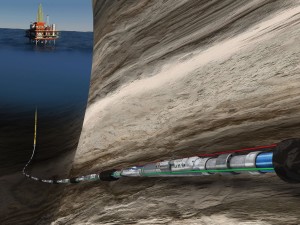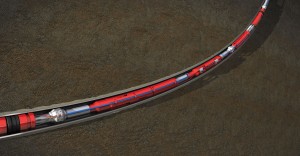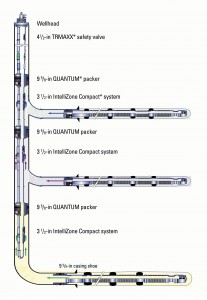Industry maps smarter way to build wellbores
In deepwater and unconventionals, intelligent completion systems emerge as tools for flow control, zone isolation, reservoir management
By Katie Mazerov, contributing editor

Fifteen years after the first intelligent well system (IWS) was installed in Norway, the application is finally stepping out of its high-end niche and gaining broad recognition as the game-changer it was designed to be. While multizone completions in deepwater and unconventional reservoirs are driving innovation, intelligent well systems are also emerging as valuable tools for mainstream and even low-end markets, including mature and brown fields, for flow control, zone isolation and permanent monitoring.
As oil prices remain high, operators who once viewed intelligent well technology as simply an intervention-avoidance tool are seeing its benefit as a reservoir management and optimization system and including the technology in their well completion plans.
“With continued demand for petroleum energy and political uncertainty in areas that produce the majority of the world’s oil, most operators are looking for oil in more challenging and demanding places, such as deepwater,” said Savio Saldanha, senior product manager of Intelligent Flow Control, Halliburton’s Completion Tools business line. “With significant investment stakes in such high-risk environments, operators are looking to intelligent well completions (IWC) to not only help constrain capital spending but to maximize reservoir productivity.”
With the increase in reliability, market acceptance of intelligent completions technology is growing. “More and more operators are wanting to implement this technology to various segments of the completion market,” Mr Saldanha said. He estimates the industry has installed roughly 1,000 IWCs since 1997, with Halliburton responsible for 550 of those using its SmartWell system intelligent completion technology. By 2008, the company had installed 41 deepwater IWCs; that number has increased to 111 and is growing.
Intelligent completion is now an integral part of any deepwater development, and so much so that, in deepwater plays such as the Gulf of Mexico’s (GOM) Lower Tertiary Formation, characterized by continuous zones as long as 3,000 ft, operators are looking to IWC technology to help produce these expansive reservoirs as multizone completions.
“A certain amount of technological innovation will be required in these areas as operators consider integrating intelligent completions with sand-control technology, with the intent of completing the reservoirs in a single trip or a few trips, as opposed to multiple trips,” he added. The GOM’s high-pressure, high-temperature (HPHT) conditions are also fostering innovation.
Unconventional Intelligence
Besides deepwater, IWC systems also can help improve the economics in unconventional reserves. “For example, we’re looking at how intelligent completion systems, such as the sSteam valve, can assist in steam-assisted gravity draining operations by allowing for uniform placement of steam across the wellbore to help produce the reserves more economically,” Mr Saldanha said.

For the unconventional market where frac stimulation is required, Halliburton has designed a frac valve that will allow multiple zones to be stimulated selectively with no intervention from the surface. Where the artificial lift market is concerned, the company is looking at running intelligent completion technology in electric submersible pump (ESP) wells. “ESP pumps need to be replaced periodically,” he explained. “To avoid pulling the entire completion, we have designed a disconnect tool that allows us to keep the lower intelligent completion in the hole and just retrieve the ESP pump and replace it.”
But the greatest potential for intelligent completion technology is in the overall reservoir optimization process, an area the industry has not yet fully embraced, Mr Saldanha believes. “The correct implementation of an intelligent completion system can deliver substantial benefits,” he said. “An IW system does not deliver maximum benefit unless it is included as part of the optimization process. This involves feeding critical data, such as temperature, pressure and flow rates provided by the IW system back into a reservoir management software to achieve an even workflow process that will allow operators to maximize every drop of oil.”
Another growing arena for IW technology lies in extreme reservoir contact and maximum reservoir contact wells in high-volume fields, explained Joseph Eck, product line manager for Intelligent Completions at Schlumberger. “The driver behind this and other applications beyond the deepwater sector is recovery,” he said. “Many in the industry focus on production – get it now, get it faster – but for operators really pushing IW technologies, the goal is to extract a higher percentage of oil and gas from the reservoir than they were able to do previously.”
Developing a Roadmap
Over the past two years, Schlumberger has focused on advancing cost-effective technologies for multistage completions for a range of offshore and land applications. These include the development of downhole wet mates for hydraulic and electric power and communications, enabling deployment of IW systems in the lower zone that connect back to surface when running the upper completion. Bandwidth limitations have led Schlumberger to develop technologies in subsea controls specific to IW systems, enabling subsea integration that goes beyond the standard subsea and controls architecture.
“We have a roadmap that looks well into the future to determine what we need to develop both short- and long-term to bring value to customers and bring recovery up to a high level,” Mr Eck noted. “We’ve expanded the sensing ability of these intelligent completion systems because often, the sensing was done above the IW systems. Now, with some of the new systems in the field, we are looking to expand the sensing into the laterals and the mother bore in combination with flow control devices.”
Schlumberger believes that its IntelliZone Compact modular zonal management system is a key development; it is a fully integrated flow control system for multizone wells that provides an alternative to sliding sleeves and conventional flow control completion systems. The system integrates a flow control valve, a packer, an optional pressure and temperature monitoring system with valve-position sensing, and an optional multidrop module.

“The excessive need for customization and lack of a common well architecture have made the cost of IW systems artificially high,” Mr Eck said. “With integrated platforms such as IntelliZone Compact, the cost reliability/value quotient is more advantageous to operators. An integrated design allows these systems to be more industrialized – faster to design, faster to deliver and deploy. We’ve seen an increase in recovery between 1 ½ to 2 times the rate over conventional well designs with this system.”
The technology has been deployed in several countries across all continents and for diverse applications, including zonal control in conventionally commingled producers, selective zonal control for water shut-off, in-carbonate wells, replacement of mechanical intervention technologies, multizone extended well testing, selective water injection and lateral control in a tri-lateral well.
Where the industry has lagged is in developing integrated work flows for modeling pre-job and post-job analysis, Mr Eck maintains. “Pre-job issues revolve around understanding and predicting the value of IW systems. But the biggest gap involves the use and understanding of data to drive the value of these systems,” he continued. “This has consistently masked the true value of intelligent wells in what they can deliver.”
Stem-to-stern Solutions

By providing flow control, permanent monitoring and retrieval of downhole data for decision-making, intelligent well systems are taking the completion market from one of providing solutions for stabilizing the wellbore to one of managing the payzone, said Ricardo Tirado, production line manager, Intelligent Well Systems for Baker Hughes. “The benefits are significant in terms of capital expenditure savings, lower operating expenses and fewer wells drilled,” he said. “These systems can be controlled and monitored remotely, delivering stem-to-stern solutions that help operators better manage reservoirs and increase recovery.”
Baker Hughes has deployed its InForce hydraulic intelligent well system globally, including a marginal field that was discovered alongside a target reservoir in the North Sea. “The operator couldn’t justify the cost of dedicating another well to the smaller reservoir, but rather than leave it unproduced, drilled a multilateral well to intersect both reservoirs with one well,” Mr Tirado said. “We knew this smaller reservoir would produce water before the main one would, so we used the system to remotely isolate the problem zone so the operator could produce oil and avoid an intervention.”
But service companies are seeing a migration from traditional hydraulic IWS to systems with electric valves and components, which Baker Hughes is developing. “The level of functionality with electric systems is better than what we can achieve with hydraulic systems, but the economics are also different,” Mr Tirado explained. “Not every well can justify the cost of an electric system, which uses components borrowed from the aerospace industry.”
“Typically, hydraulic systems have multiple control lines coming through the wellhead, so we need the infrastructure to control those lines,” said Darrin Willauer, Baker Hughes product line director for Intelligent Production Systems. “In wells with three to five zones, that is often not an issue, but with the number of zones increasing to six zones — and some design plans calling for eight to 10 zones — the number of hydraulic lines becomes an issue. With electric completions, we can run multiple valves off a single line. In this way, some of the cost of installing an electric completion is offset by reducing the subsea infrastructure costs.”

Electric IWS completions can be cost-effective for prolific, multizone wells in deepwater GOM reservoirs; however, operators are starting to show interest in using them to extend the life of mature onshore wells to delay water production or shut off water-producing zones, Mr Willauer noted.
Advances in fiber optics are bringing new monitoring capabilities to the industry, such as distributed temperature sensing along the entire length of a well. “We can measure temperature at 1- and 0.5-meter increments along the length of the well and use that information to determine where the flows are coming in,” he said. “During a hydraulic frac, we can use fiber optics to determine where the fluid is going into the well so we know where the fracture is occurring.”
New gauges, such as the SureSENS 175, provide accurate pressure and temperature data for temperatures up to 350°F. “For hotter environments, we’ve developed a portfolio of fiber-optic pressure/temperature gauges that can withstand temperatures higher than 450°F,” Mr Willauer said.
“Over the last several years, we’ve seen customers more willing to run sophisticated instrumentation like this on their wells to make decisions that result in better reservoir management and recovery,” he continued. “We need to understand how the reservoir is going to produce, then provide the right completion equipment to maximize recovery of a formation and provide downhole data in a way that allows our customers to take appropriate action.”
SmartWell is a registered term of Halliburton; sSteam is a trademarked term of Halliburton. IntelliZone Compact is a mark of Schlumberger. InForce and SureSENS 175 are trademarked terms of Baker Hughes.




